More likely end up with Dino’s because of lack of competing microflora. Dino’s themselfs will bottom out nutrients.I actually see the opposite on R2R, many report it quickly bottoms out nutrients and they end up with dinos. I saw phosphates go to zero in short order a couple years ago when I used it.
Navigation
Install the app
How to install the app on iOS
Follow along with the video below to see how to install our site as a web app on your home screen.
Note: This feature may not be available in some browsers.
More options
You are using an out of date browser. It may not display this or other websites correctly.
You should upgrade or use an alternative browser.
You should upgrade or use an alternative browser.
Understanding Vibrant: Algaefix, Polixetonium Chloride / Busan 77
- Thread starter taricha
- Start date
- Tagged users None
- Joined
- Jul 18, 2019
- Messages
- 330
- Reaction score
- 542
I actually see the opposite on R2R, many report it quickly bottoms out nutrients and they end up with dinos. I saw phosphates go to zero in short order a couple years ago when I used it.
I disagree. A simple search of the vibrant thread seems to suggest the opposite:

Search results for query: nitrate
 www.reef2reef.com
www.reef2reef.com
- Joined
- Jul 5, 2019
- Messages
- 707
- Reaction score
- 728
That search actually has many commenting that nutrients bottomed out actually.I disagree. A simple search of the vibrant thread seems to suggest the opposite:

Search results for query: nitrate
www.reef2reef.com
- Joined
- Jul 18, 2019
- Messages
- 330
- Reaction score
- 542
I think given that there is a mix of people stating that their nutrients are going UP and some that say it goes down you cannot with confidence say that there is an effect. That fact alone refutes the idea that vibrant will undoubtedly reduce Nitrate and Phosphorous. If you would like to spend time going through the thread and tally instances of one versus the other be my guest. Maybe we can conclude that in general one result is more frequent. But it should be obvious to anyone who clicks that link, the results are not cut and dry. Just looking at the first page of results shows near unanimous increases in nutrients.That search actually has many commenting that nutrients bottomed out actually.
- Joined
- May 22, 2016
- Messages
- 6,545
- Reaction score
- 10,101
Part 3: If Vibrant contains other ingredients, they are insufficient to change the properties from Algaefix in any easily measurable way
Part 1 (first post) is about establishing the identity of the active ingredient and Part 2 (post 16) is about establishing its concentration. Part 3 is about looking for other things either indicated on the label or that would be chemically relevant that may have been added and would distinguish Vibrant from Algaefix.
I actually spent a fairly large amount of time trying to eliminate the very boring/stupid possibility that Vibrant simply replicated the Algaefix ingredient and concentration and added nothing else. I was unable to eliminate that possibility. Below are measurements and observations, none of which distinguish vibrant from algaefix, and some of which distinguish vibrant from all other hobby bacterial products, and others are relevant to the claimed ingredients on the label.
A. Density
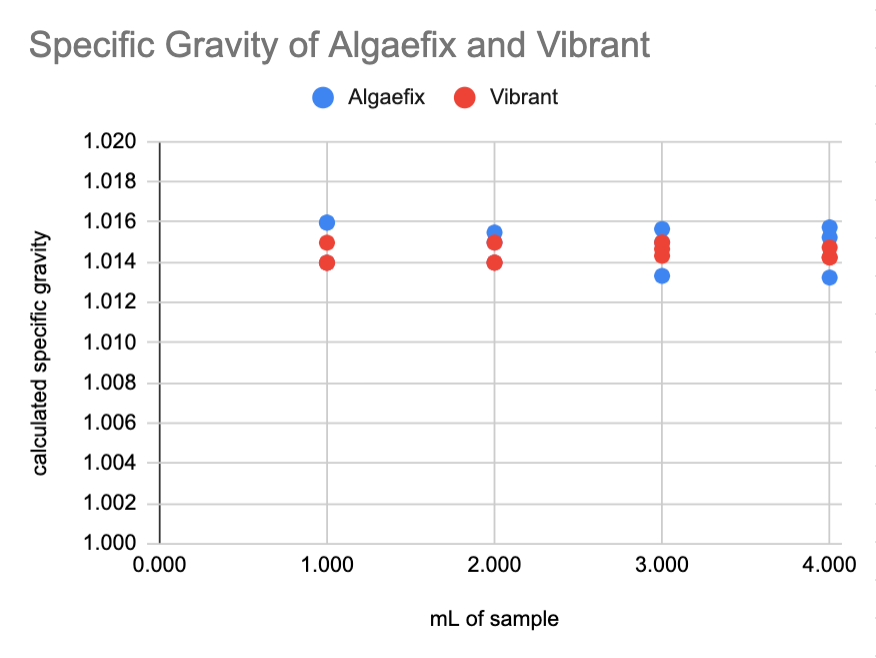
Specific gravities of Vibrant and Algaefix were measured to be indistinguishable. Other hobby bacterial products I measured were everywhere from 1.000 to 1.026.
B. Mass of Dried Residue
3.00 mL each of Algaefix and Vibrant (and distilled water for comparison) were dried on a coffee warmer overnight to compare the amount of non-volatile material remaining.

Algaefix and Vibrant seem to contain an indistinguishable amount of volatile / nonvolatile material (above data in grams).
C. Dried drop appearance
I dried drops of a bunch of different products on a glass pane overnight on a coffee warmer to compare the appearance and texture of what’s left behind.
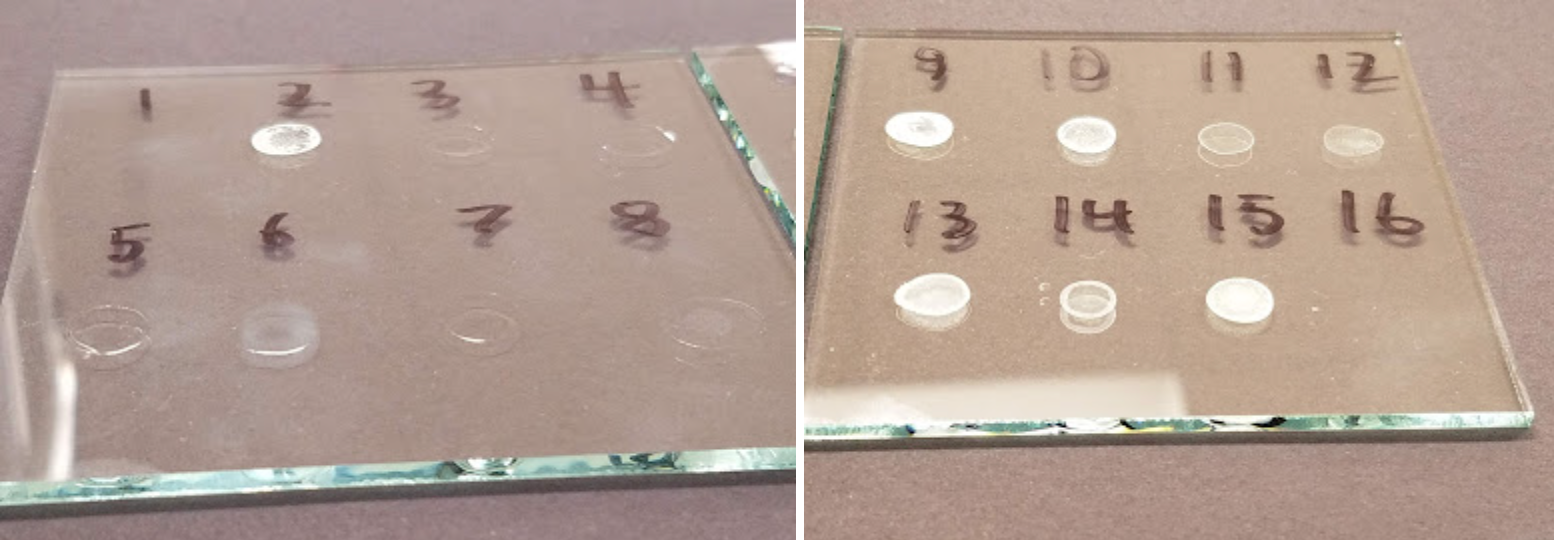
1- Distilled, 2- saltwater, 3- Algaefix, 4- Vibrant, 5- Algae Control (Tetra), 6- Algae Clean Out (Fritz), 7- Vibrant Fresh, 8- Waste Away, 9- MicroBacter7, 10- MicroBacter Clean, 11- Pristine (Seachem), 12- Fritz 460, 13- Bacto Therapy (Fauna Marin), 14- One & Only, 15- Biospira, 16- none.
All bacterial blends and saltwater dried leaving behind crusty opaque residue. The polixetonium chloride algaecides (3 through 7) dry clear leaving behind a sticky totally clear spot, except Algae Clean Out, it contains something additional and dries cloudy. The polyquat algaecide products all rehydrated and became wet again when left cool in the air for hours. No others did.
D. Product pH
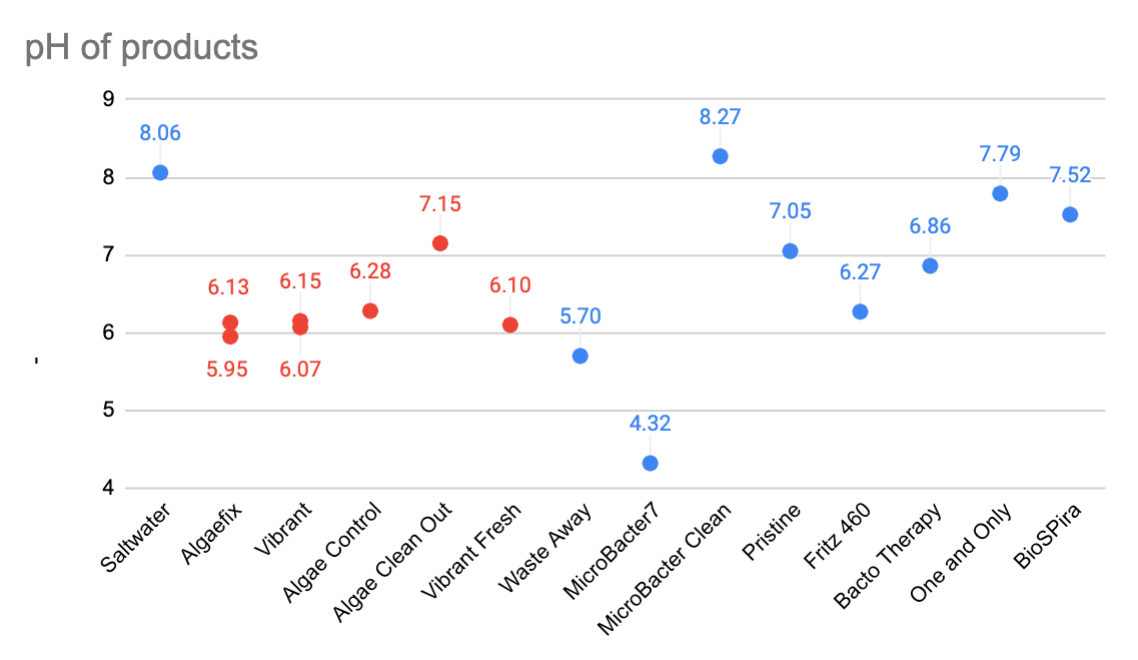
I measured pH for the algaecides (red) and the bacterial products. Algaefix and Vibrant (and Vibrant Freshwater) are indistinguishable in pH, two bottles of each shows the bottle to bottle variation. Algae Clean Out (Fritz) again shows it has other additives.
F. Failure of Hanna PO4 test
This is a random one, but the coagulation properties of polixetonium chloride means that a tiny amount of it can break the otherwise very reliable Hanna ULR P test chemistry. This is at 4mL of Algaefix and Vibrant per Liter of tank water.
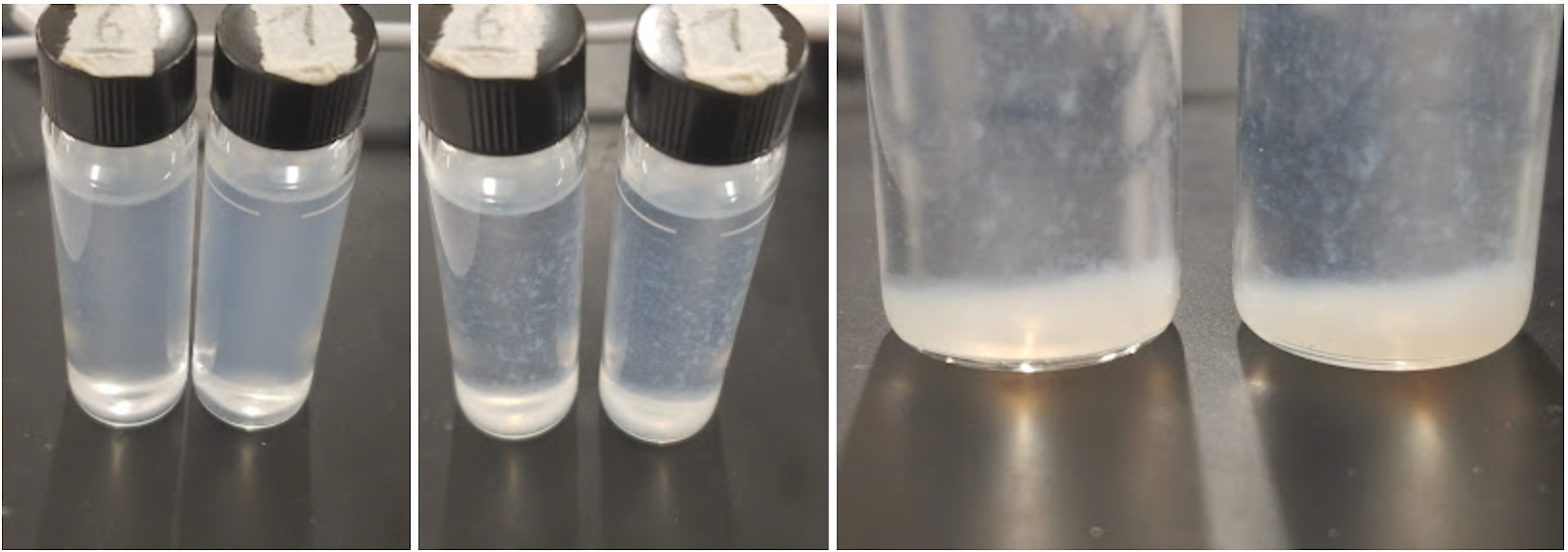
Cloudiness after 2 min shake, coagulation and falling out of solution by 10min. (Algaefix left cuvette, vibrant the right.)
G. Product Fluorescence
Organics are often moderately fluorescent under UV light, many waste products of bacterial metabolism as well as dissolved organic carbon released by algae are usually detectably fluorescent. The polyquat algaecides and a bunch of bacterial products were all filtered (0.22 um) and then 2.0mL of the clear filtrate from each was excited at 365nm UV and the fluorescence was recorded.
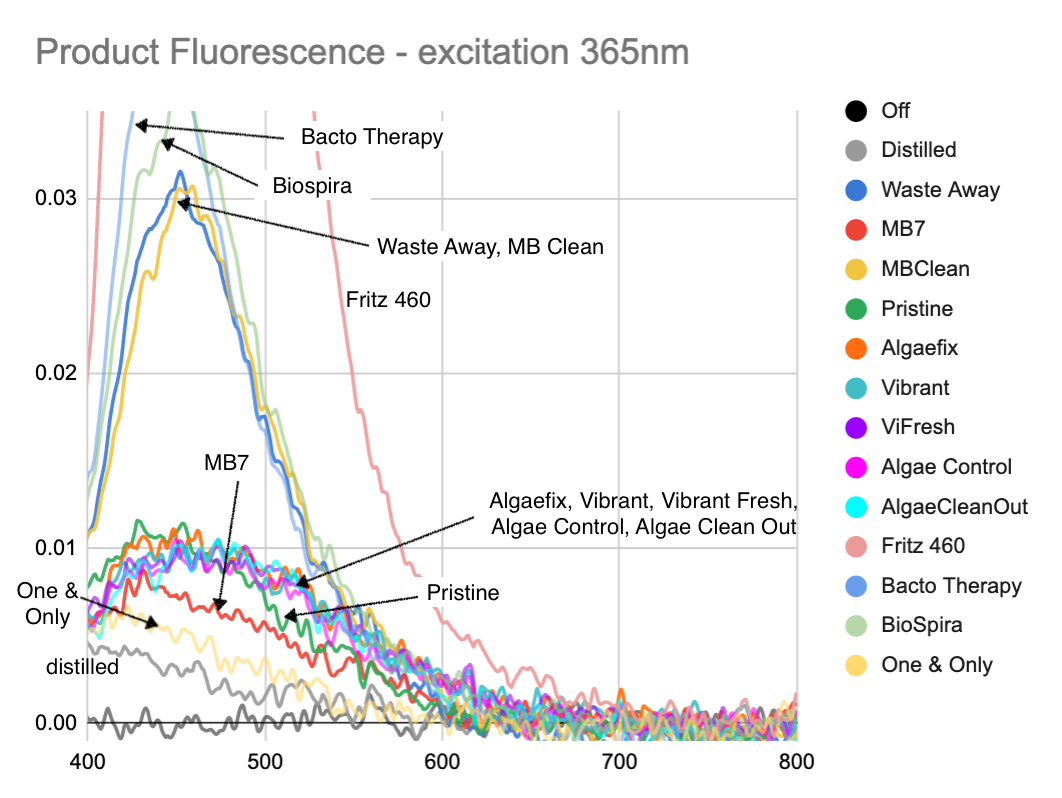
You can see that all the polyquat algaecides have the same fluorescent response. Many bacterial products were much more fluorescent, and a couple were noticeably less. You can have very low media fluorescence by simply delivering filtered cells/spores in a very blank medium. If there were a lot of compounds derived from bacterial metabolism, like a straight bacterial culture, the fluorescence would be quite significant.
H. Centrifuged Pellet
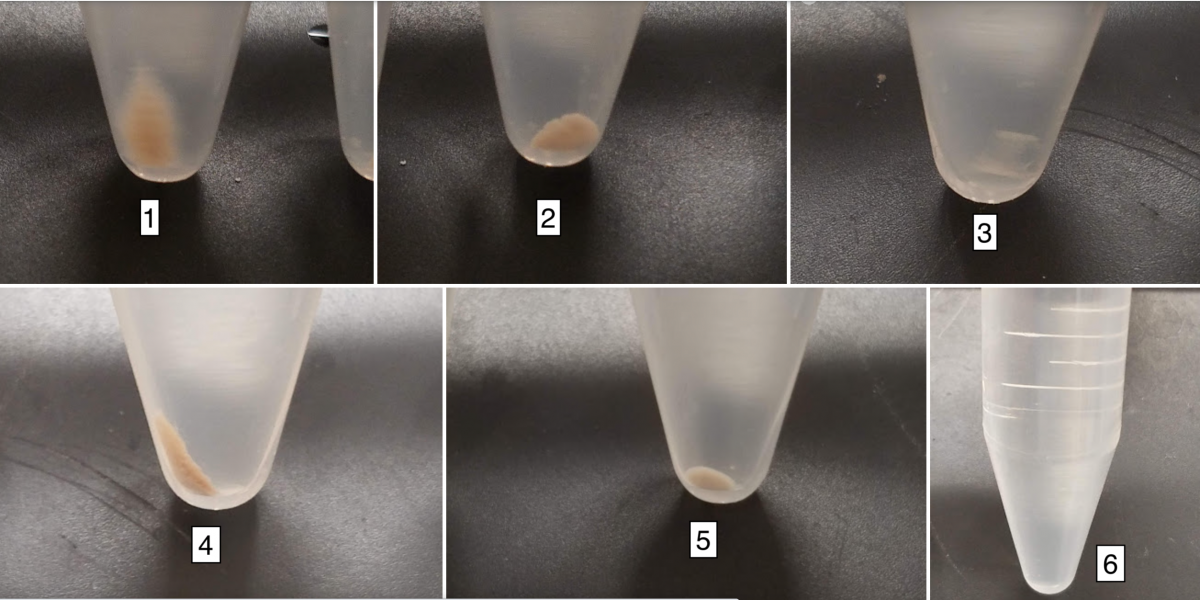
1 - Microbacter7. 2 - Waste Away. 3 - Bacto Therapy (Fauna Marin). 4 - FritzZyme 460. 5 - Pristine (seachem). 6 - Vibrant, (Same for Algaefix - not pictured).
Unlike every other hobby bacterial product I’ve gotten my hands on, Vibrant produces no pellet or condensed material when centrifuged. Each tube was 10mL of thoroughly shaken product, centrifuged 4000rpm for 10min. Spores like those in Waste Away and live cells like the nitrifiers in biospira (not pictured) all pellet without difficulty. There is far far less (if any) pelletable material in either Vibrant or Algaefix.
I. Culture-up
I’ve done this with multiple different bottles of Vibrant, new and old. It seems not to be a fluke. It is possible to culture up the contents of Vibrant, and also Algaefix. Therefore neither product is sterile in spite of the amount of polixetonium chloride present.
Below is Instant Ocean at 1.026 S.G. enriched with LB broth + glucose, 10mL in each. Picture after 7 days.
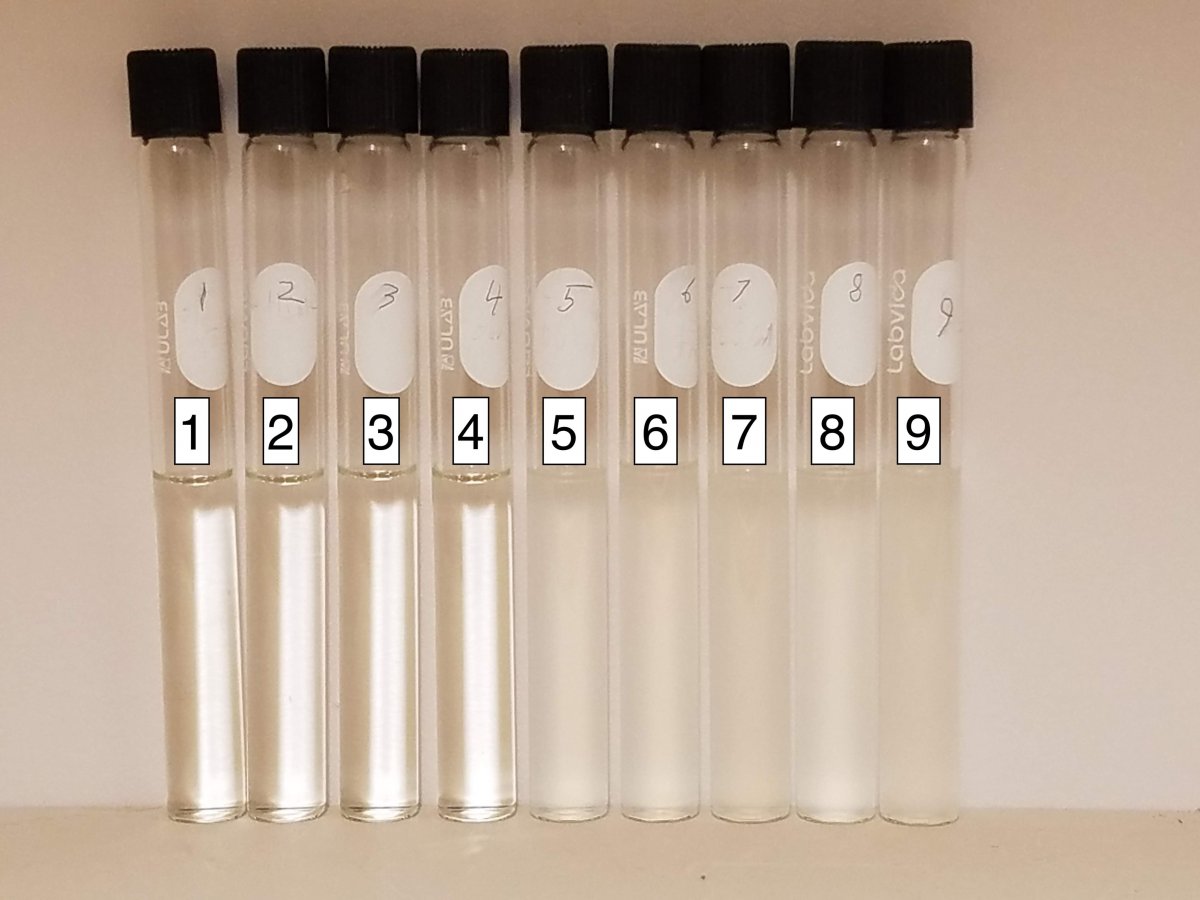
I added 1 drop (0.05mL) of each of the following
1 & 2 duplicates - Distilled water (stayed clear for 7+ days)
3 & 4 duplicates - Vibrant run through an 0.22um syringe filter (stayed clear for 7+ days)
5 & 6 duplicates - Vibrant the same, except syringe filter removed (cloudy by 57hr)
7 Algaefix (cloudy by 45hr)
8 MicroBacter7 (cloudy by 48 hours)
9 Aquarium water (cloudy by 18 hrs)
So it is totally possible to culture up bacteria from bottles of 4.5% polyquat algaecide. This kind of culture-up with a rich food source does not distinguish between the presumably random contamination in Algaefix and a bona fide bacterial product like Microbacter7. Thus nothing can be concluded about Vibrant here except it isn’t sterile.
J. Saltwater/Freshwater bacterial activity suppression
I took aquarium water and added 250mg/L ground fish flake, 100mg/L glucose, and 2 drops/L methylene blue to show when O2 gets depleted by bacterial growth. Methylene blue loses its color when bacteria consume all the O2 in the water.
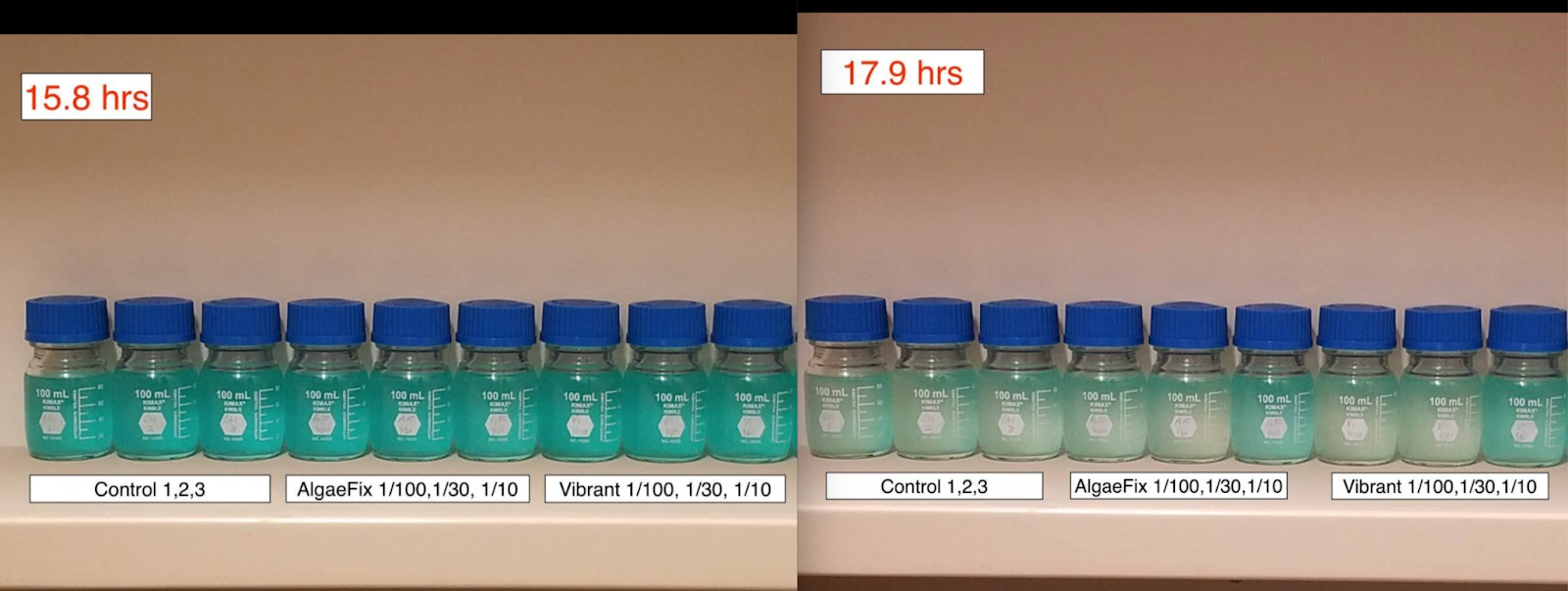
In saltwater the effect is very minor, Algaefix and Vibrant in amounts of 1/10 of the entire sample slowed down the decoloration barely - by under 1hr out of ~18 hours.
Because of the cationic nature of these chemicals they are expected to be more potent in freshwater than in hard water.
Doing the same thing as above with water from a lake near my house (added fish flake, glucose and methylene blue) showed a far stronger effect.
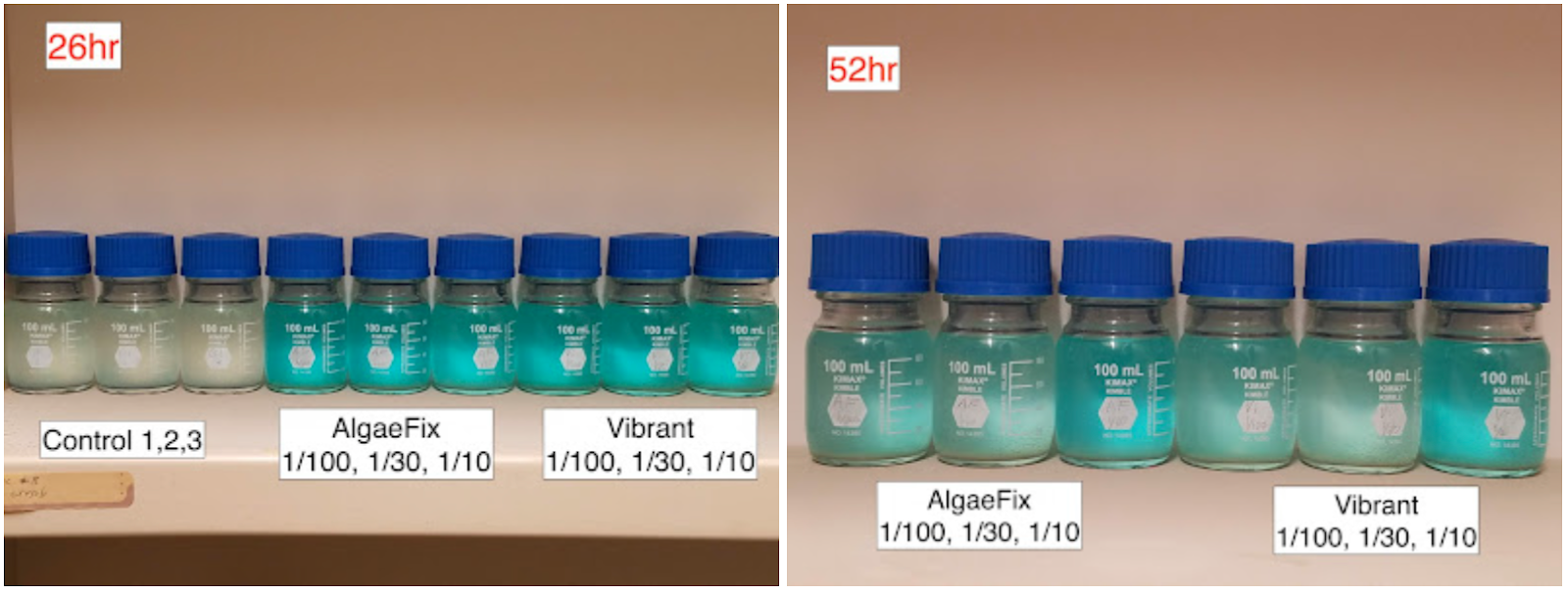
Even 1/100 of algaefix and Vibrant delayed the decolorization by bacteria for over a day. But the effect is not absolute, the high concentration - Algaefix and Vibrant at 1/10th of the whole sample still decolorized a few hours later. (for comparison, a 1/10th sample of Waste Away has a strong preservative, and never decolorized, even a couple of months later.)
Whether saltwater or fresh, the timeline of the decolorization by bacteria was exactly mirrored in Algaefix and Vibrant.
K. Chemical and Bacterial Digestibility
In order to look for organics without losing any volatiles as could have occurred in the drying preparation for the professional lab tests in part 1, I did COD and BOD tests. COD is chemical oxygen demand - that tests the amount of organic material by heated acidic digestion with a strong oxidizer. It will measure essentially all organics, including in cells. BOD measures organics by determining the Oxygen consumed when bacteria etc are fed something.
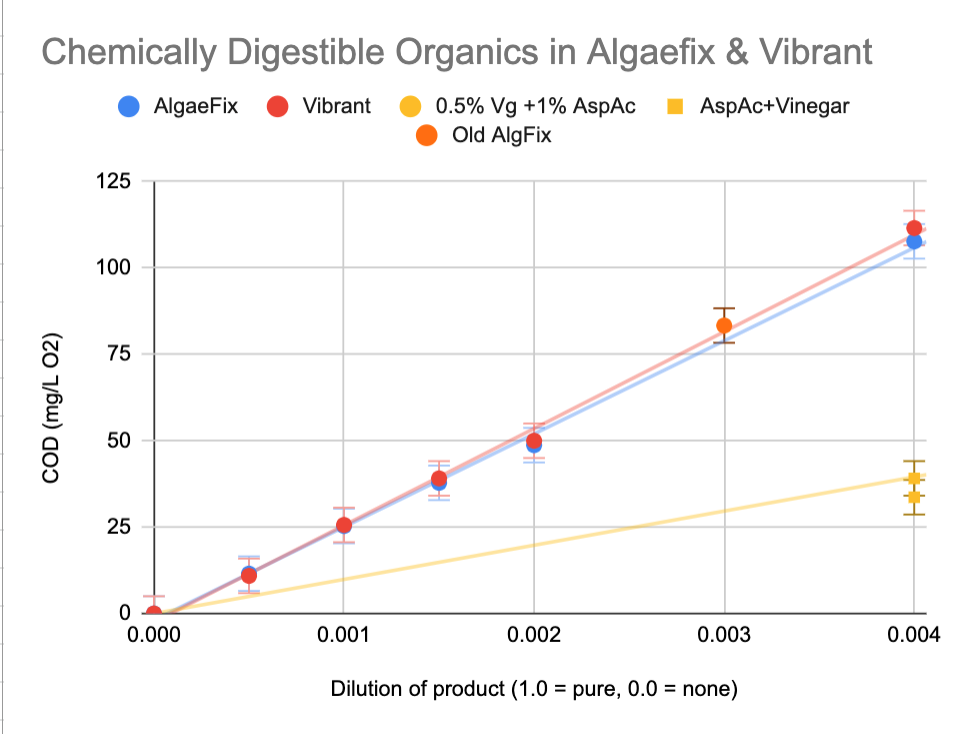
This graph shows COD: Algaefix and Vibrant contain the same amount of chemically digestible material. The yellow line represents the label organics that Vibrant claims. If it had those added to the same amount of polyquat as algaefix, then the lines for Algaefix and Vibrant would not agree as they do.
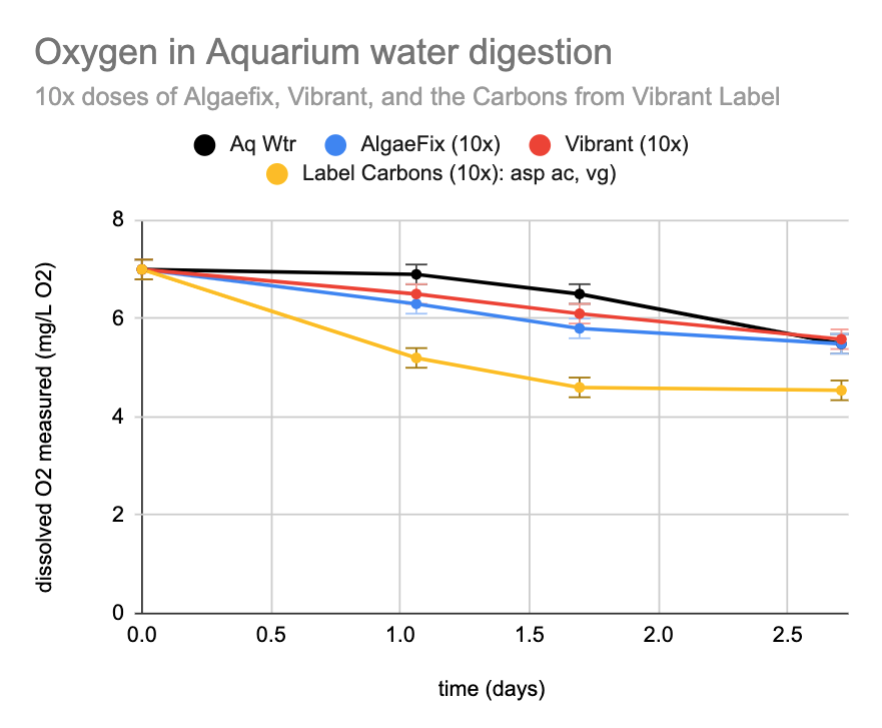
This graph shows the O2 consumed by aquarium water with either nothing, or 10x doses each of Algaefix, Vibrant, or the label organics claimed by Vibrant added. This data is in agreement with the polyquat being essentially indigestible, and the label amounts of aspartic acid claimed by Vibrant being absent. Vinegar at 0.5% (which is itself only ~5% acetic acid) is too tiny to be detected by this analysis.
These two measurements together do not support the possibility of significant organics in Vibrant either added to the polyquat as aspartic acid or other carbon dose, or as a significant amount of bacteria / bacterial product.
L. Addition of Vinegar
I used a small amount of vinegar to look at the possibility of Vibrant having 0.5% vinegar added. The product seems lightly buffered and tiny additions of vinegar move the pH a notable amount..
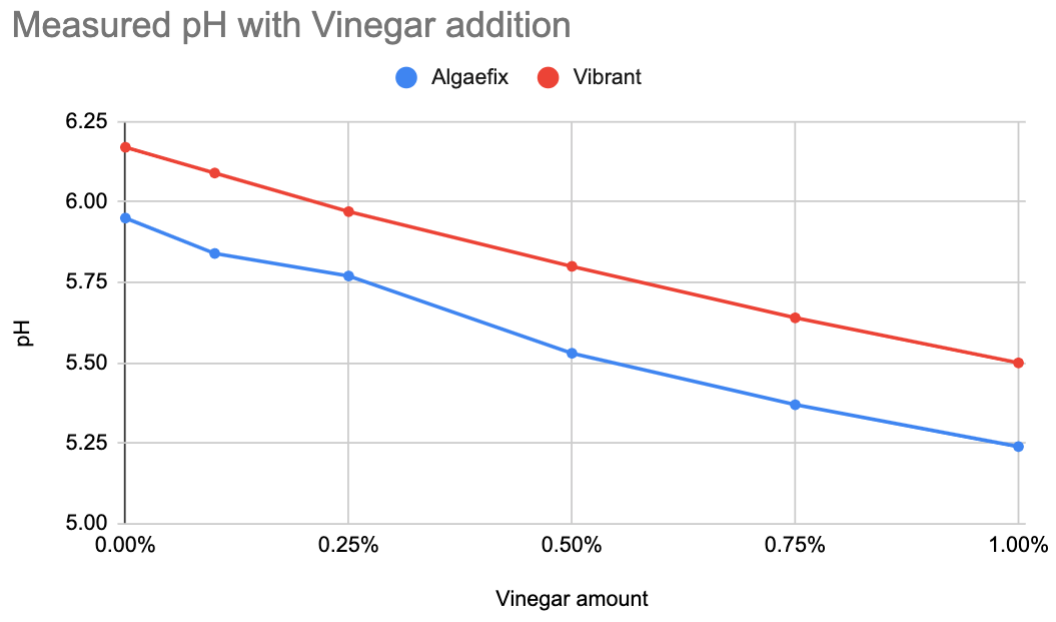
The two products react to vinegar additions the same, and the addition of 0.5% vinegar created a pH drop almost twice the difference in pH between the two. Nothing conclusive, but makes vinegar seem unlikely since the pHs of Vibrant and Algaefix are so close.
5 days after I did the above pH check, I noticed both tubes that had 1% vinegar added had microbial growth in colonies spread around the tubes. Below is a picture of each.
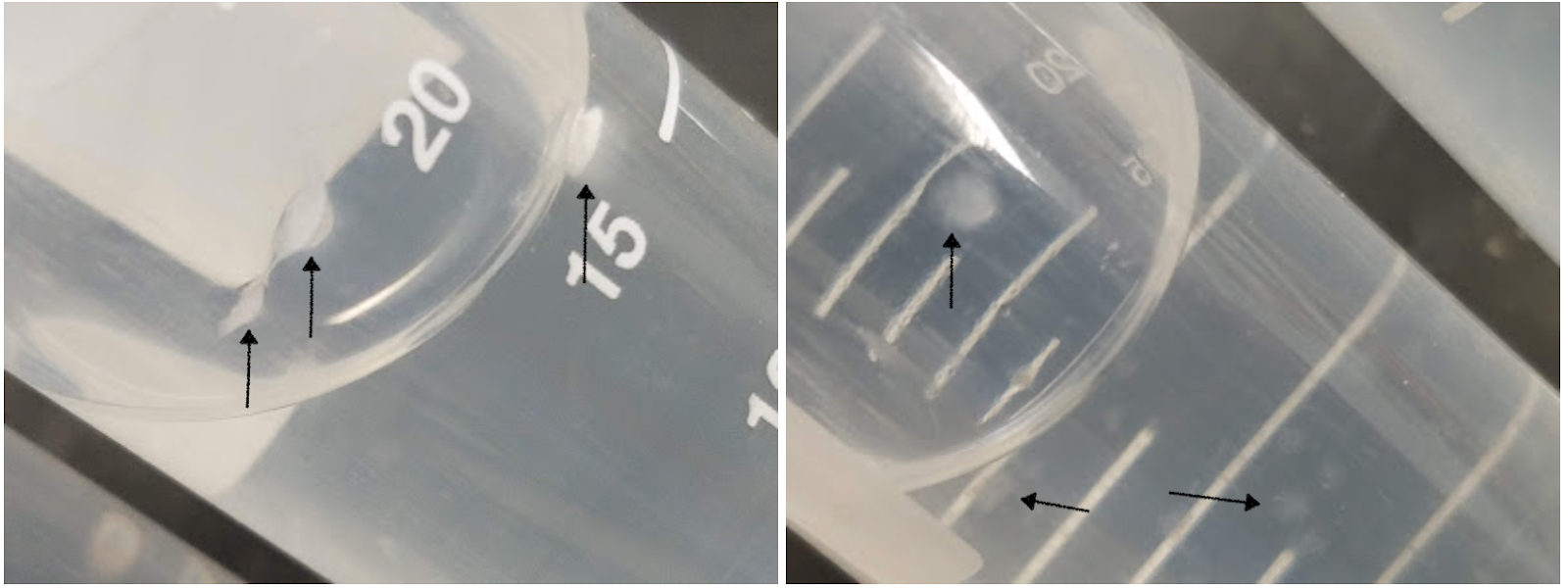
Left is the white growth on the tube that grew in algaefix with 1% vinegar and right is the white colonies that grew in Vibrant with 1% vinegar.
Here is a microscope image of the colonies from each, showing cells arranged in filaments (to confirm this isn't abiotic precipitation).

It seems that even at 4.5% polixetonium chloride, microbial activity isn’t prevented and if organics had been added to Vibrant, then they would not be stable. If Vibrant had 0.5% vinegar added to it, then it likely would have been consumed and bacteria would have grown. Shaking the bottle would dislodge the colonies and biomass would be apparent when examining the product, centrifuging, etc. The clarity of Vibrant suggests 0.5% vinegar is not a potential addition.
To summarize, part 1 establishes the ingredient as that in Algaefix, and part 2 establishes the concentration as the same in Algaefix. That is the only important part of the story for understanding how it functions as an algaecide. Part 3 illustrates that if something were added to make Vibrant not the same as algaefix, then it did not change the density, amount of volatile or non-volatile material, appearance of dried drops, pH, fluorescent emissions, nor create any centrifuge pellet material. Any hypothetical addition furthermore did not affect the way it cultures up, or suppresses bacterial growth, nor change the amount of chemical or biologically digestible material, nor the pH and bacterial growth response to vinegar.
Part 1 (first post) is about establishing the identity of the active ingredient and Part 2 (post 16) is about establishing its concentration. Part 3 is about looking for other things either indicated on the label or that would be chemically relevant that may have been added and would distinguish Vibrant from Algaefix.
I actually spent a fairly large amount of time trying to eliminate the very boring/stupid possibility that Vibrant simply replicated the Algaefix ingredient and concentration and added nothing else. I was unable to eliminate that possibility. Below are measurements and observations, none of which distinguish vibrant from algaefix, and some of which distinguish vibrant from all other hobby bacterial products, and others are relevant to the claimed ingredients on the label.
A. Density
Specific gravities of Vibrant and Algaefix were measured to be indistinguishable. Other hobby bacterial products I measured were everywhere from 1.000 to 1.026.
B. Mass of Dried Residue
3.00 mL each of Algaefix and Vibrant (and distilled water for comparison) were dried on a coffee warmer overnight to compare the amount of non-volatile material remaining.
Algaefix and Vibrant seem to contain an indistinguishable amount of volatile / nonvolatile material (above data in grams).
C. Dried drop appearance
I dried drops of a bunch of different products on a glass pane overnight on a coffee warmer to compare the appearance and texture of what’s left behind.
1- Distilled, 2- saltwater, 3- Algaefix, 4- Vibrant, 5- Algae Control (Tetra), 6- Algae Clean Out (Fritz), 7- Vibrant Fresh, 8- Waste Away, 9- MicroBacter7, 10- MicroBacter Clean, 11- Pristine (Seachem), 12- Fritz 460, 13- Bacto Therapy (Fauna Marin), 14- One & Only, 15- Biospira, 16- none.
All bacterial blends and saltwater dried leaving behind crusty opaque residue. The polixetonium chloride algaecides (3 through 7) dry clear leaving behind a sticky totally clear spot, except Algae Clean Out, it contains something additional and dries cloudy. The polyquat algaecide products all rehydrated and became wet again when left cool in the air for hours. No others did.
D. Product pH
I measured pH for the algaecides (red) and the bacterial products. Algaefix and Vibrant (and Vibrant Freshwater) are indistinguishable in pH, two bottles of each shows the bottle to bottle variation. Algae Clean Out (Fritz) again shows it has other additives.
F. Failure of Hanna PO4 test
This is a random one, but the coagulation properties of polixetonium chloride means that a tiny amount of it can break the otherwise very reliable Hanna ULR P test chemistry. This is at 4mL of Algaefix and Vibrant per Liter of tank water.
Cloudiness after 2 min shake, coagulation and falling out of solution by 10min. (Algaefix left cuvette, vibrant the right.)
G. Product Fluorescence
Organics are often moderately fluorescent under UV light, many waste products of bacterial metabolism as well as dissolved organic carbon released by algae are usually detectably fluorescent. The polyquat algaecides and a bunch of bacterial products were all filtered (0.22 um) and then 2.0mL of the clear filtrate from each was excited at 365nm UV and the fluorescence was recorded.
You can see that all the polyquat algaecides have the same fluorescent response. Many bacterial products were much more fluorescent, and a couple were noticeably less. You can have very low media fluorescence by simply delivering filtered cells/spores in a very blank medium. If there were a lot of compounds derived from bacterial metabolism, like a straight bacterial culture, the fluorescence would be quite significant.
H. Centrifuged Pellet
1 - Microbacter7. 2 - Waste Away. 3 - Bacto Therapy (Fauna Marin). 4 - FritzZyme 460. 5 - Pristine (seachem). 6 - Vibrant, (Same for Algaefix - not pictured).
Unlike every other hobby bacterial product I’ve gotten my hands on, Vibrant produces no pellet or condensed material when centrifuged. Each tube was 10mL of thoroughly shaken product, centrifuged 4000rpm for 10min. Spores like those in Waste Away and live cells like the nitrifiers in biospira (not pictured) all pellet without difficulty. There is far far less (if any) pelletable material in either Vibrant or Algaefix.
I. Culture-up
I’ve done this with multiple different bottles of Vibrant, new and old. It seems not to be a fluke. It is possible to culture up the contents of Vibrant, and also Algaefix. Therefore neither product is sterile in spite of the amount of polixetonium chloride present.
Below is Instant Ocean at 1.026 S.G. enriched with LB broth + glucose, 10mL in each. Picture after 7 days.
I added 1 drop (0.05mL) of each of the following
1 & 2 duplicates - Distilled water (stayed clear for 7+ days)
3 & 4 duplicates - Vibrant run through an 0.22um syringe filter (stayed clear for 7+ days)
5 & 6 duplicates - Vibrant the same, except syringe filter removed (cloudy by 57hr)
7 Algaefix (cloudy by 45hr)
8 MicroBacter7 (cloudy by 48 hours)
9 Aquarium water (cloudy by 18 hrs)
So it is totally possible to culture up bacteria from bottles of 4.5% polyquat algaecide. This kind of culture-up with a rich food source does not distinguish between the presumably random contamination in Algaefix and a bona fide bacterial product like Microbacter7. Thus nothing can be concluded about Vibrant here except it isn’t sterile.
J. Saltwater/Freshwater bacterial activity suppression
I took aquarium water and added 250mg/L ground fish flake, 100mg/L glucose, and 2 drops/L methylene blue to show when O2 gets depleted by bacterial growth. Methylene blue loses its color when bacteria consume all the O2 in the water.
In saltwater the effect is very minor, Algaefix and Vibrant in amounts of 1/10 of the entire sample slowed down the decoloration barely - by under 1hr out of ~18 hours.
Because of the cationic nature of these chemicals they are expected to be more potent in freshwater than in hard water.
Doing the same thing as above with water from a lake near my house (added fish flake, glucose and methylene blue) showed a far stronger effect.
Even 1/100 of algaefix and Vibrant delayed the decolorization by bacteria for over a day. But the effect is not absolute, the high concentration - Algaefix and Vibrant at 1/10th of the whole sample still decolorized a few hours later. (for comparison, a 1/10th sample of Waste Away has a strong preservative, and never decolorized, even a couple of months later.)
Whether saltwater or fresh, the timeline of the decolorization by bacteria was exactly mirrored in Algaefix and Vibrant.
K. Chemical and Bacterial Digestibility
In order to look for organics without losing any volatiles as could have occurred in the drying preparation for the professional lab tests in part 1, I did COD and BOD tests. COD is chemical oxygen demand - that tests the amount of organic material by heated acidic digestion with a strong oxidizer. It will measure essentially all organics, including in cells. BOD measures organics by determining the Oxygen consumed when bacteria etc are fed something.
This graph shows COD: Algaefix and Vibrant contain the same amount of chemically digestible material. The yellow line represents the label organics that Vibrant claims. If it had those added to the same amount of polyquat as algaefix, then the lines for Algaefix and Vibrant would not agree as they do.
This graph shows the O2 consumed by aquarium water with either nothing, or 10x doses each of Algaefix, Vibrant, or the label organics claimed by Vibrant added. This data is in agreement with the polyquat being essentially indigestible, and the label amounts of aspartic acid claimed by Vibrant being absent. Vinegar at 0.5% (which is itself only ~5% acetic acid) is too tiny to be detected by this analysis.
These two measurements together do not support the possibility of significant organics in Vibrant either added to the polyquat as aspartic acid or other carbon dose, or as a significant amount of bacteria / bacterial product.
L. Addition of Vinegar
I used a small amount of vinegar to look at the possibility of Vibrant having 0.5% vinegar added. The product seems lightly buffered and tiny additions of vinegar move the pH a notable amount..
The two products react to vinegar additions the same, and the addition of 0.5% vinegar created a pH drop almost twice the difference in pH between the two. Nothing conclusive, but makes vinegar seem unlikely since the pHs of Vibrant and Algaefix are so close.
5 days after I did the above pH check, I noticed both tubes that had 1% vinegar added had microbial growth in colonies spread around the tubes. Below is a picture of each.
Left is the white growth on the tube that grew in algaefix with 1% vinegar and right is the white colonies that grew in Vibrant with 1% vinegar.
Here is a microscope image of the colonies from each, showing cells arranged in filaments (to confirm this isn't abiotic precipitation).
It seems that even at 4.5% polixetonium chloride, microbial activity isn’t prevented and if organics had been added to Vibrant, then they would not be stable. If Vibrant had 0.5% vinegar added to it, then it likely would have been consumed and bacteria would have grown. Shaking the bottle would dislodge the colonies and biomass would be apparent when examining the product, centrifuging, etc. The clarity of Vibrant suggests 0.5% vinegar is not a potential addition.
To summarize, part 1 establishes the ingredient as that in Algaefix, and part 2 establishes the concentration as the same in Algaefix. That is the only important part of the story for understanding how it functions as an algaecide. Part 3 illustrates that if something were added to make Vibrant not the same as algaefix, then it did not change the density, amount of volatile or non-volatile material, appearance of dried drops, pH, fluorescent emissions, nor create any centrifuge pellet material. Any hypothetical addition furthermore did not affect the way it cultures up, or suppresses bacterial growth, nor change the amount of chemical or biologically digestible material, nor the pH and bacterial growth response to vinegar.
Last edited:
- Joined
- May 22, 2016
- Messages
- 6,545
- Reaction score
- 10,101
here's the PDF itself. That section I quoted from was around page 20.I clicked on link but don’t get to study you quote. I am googling to find expected half life or how it degrades but can’t find anything.
Attachments
This part, like parts 1 & 2, leaves little room for doubt as to what Vibrant contains. Very well done sir.
Some excellent Science...well done!!! This work provides great value to our Reefing community...THank you for being so diligent in your efforts.Part 3: If Vibrant contains other ingredients, they are insufficient to change the properties from Algaefix in any easily measurable way
Part 1 (first post) is about establishing the identity of the active ingredient and Part 2 (post 16) is about establishing its concentration. Part 3 is about looking for other things either indicated on the label or that would be chemically relevant that may have been added and would distinguish Vibrant from Algaefix.
I actually spent a fairly large amount of time trying to eliminate the very boring/stupid possibility that Vibrant simply replicated the Algaefix ingredient and concentration and added nothing else. I was unable to eliminate that possibility. Below are measurements and observations, none of which distinguish vibrant from algaefix, and some of which distinguish vibrant from all other hobby bacterial products, and others are relevant to the claimed ingredients on the label.
A. Density

Specific gravities of Vibrant and Algaefix were measured to be indistinguishable. Other hobby bacterial products I measured were everywhere from 1.000 to 1.026.
B. Mass of Dried Residue
3.00 mL each of Algaefix and Vibrant (and distilled water for comparison) were dried on a coffee warmer overnight to compare the amount of non-volatile material remaining.

Algaefix and Vibrant seem to contain an indistinguishable amount of volatile / nonvolatile material (above data in grams).
C. Dried drop appearance
I dried drops of a bunch of different products on a glass pane overnight on a coffee warmer to compare the appearance and texture of what’s left behind.

1- Distilled, 2- saltwater, 3- Algaefix, 4- Vibrant, 5- Algae Control (Tetra), 6- Algae Clean Out (Fritz), 7- Vibrant Fresh, 8- Waste Away, 9- MicroBacter7, 10- MicroBacter Clean, 11- Pristine (Seachem), 12- Fritz 460, 13- Bacto Therapy (Fauna Marin), 14- One & Only, 15- Biospira, 16- none.
All bacterial blends and saltwater dried leaving behind crusty opaque residue. The polixetonium chloride algaecides (3 through 7) dry clear leaving behind a sticky totally clear spot, except Algae Clean Out, it contains something additional and dries cloudy. The polyquat algaecide products all rehydrated and became wet again when left cool in the air for hours. No others did.
D. Product pH

I measured pH for the algaecides (red) and the bacterial products. Algaefix and Vibrant (and Vibrant Freshwater) are indistinguishable in pH, two bottles of each shows the bottle to bottle variation. Algae Clean Out (Fritz) again shows it has other additives.
F. Failure of Hanna PO4 test
This is a random one, but the coagulation properties of polixetonium chloride means that a tiny amount of it can break the otherwise very reliable Hanna ULR P test chemistry. This is at 4mL of Algaefix and Vibrant per Liter of tank water.

Cloudiness after 2 min shake, coagulation and falling out of solution by 10min. (Algaefix left cuvette, vibrant the right.)
G. Product Fluorescence
Organics are often moderately fluorescent under UV light, many waste products of bacterial metabolism as well as dissolved organic carbon released by algae are usually detectably fluorescent. The polyquat algaecides and a bunch of bacterial products were all filtered (0.22 um) and then 2.0mL of the clear filtrate from each was excited at 365nm UV and the fluorescence was recorded.

You can see that all the polyquat algaecides have the same fluorescent response. Many bacterial products were much more fluorescent, and a couple were noticeably less. You can have very low media fluorescence by simply delivering filtered cells/spores in a very blank medium. If there were a lot of compounds derived from bacterial metabolism, like a straight bacterial culture, the fluorescence would be quite significant.
H. Centrifuged Pellet

1 - Microbacter7. 2 - Waste Away. 3 - Bacto Therapy (Fauna Marin). 4 - FritzZyme 460. 5 - Pristine (seachem). 6 - Vibrant, (Same for Algaefix - not pictured).
Unlike every other hobby bacterial product I’ve gotten my hands on, Vibrant produces no pellet or condensed material when centrifuged. Each tube was 10mL of thoroughly shaken product, centrifuged 4000rpm for 10min. Spores like those in Waste Away and live cells like the nitrifiers in biospira (not pictured) all pellet without difficulty. There is far far less (if any) pelletable material in either Vibrant or Algaefix.
I. Culture-up
I’ve done this with multiple different bottles of Vibrant, new and old. It seems not to be a fluke. It is possible to culture up the contents of Vibrant, and also Algaefix. Therefore neither product is sterile in spite of the amount of polixetonium chloride present.
Below is Instant Ocean at 1.026 S.G. enriched with LB broth + glucose, 10mL in each. Picture after 7 days.

I added 1 drop (0.05mL) of each of the following
1 & 2 duplicates - Distilled water (stayed clear for 7+ days)
3 & 4 duplicates - Vibrant run through an 0.22um syringe filter (stayed clear for 7+ days)
5 & 6 duplicates - Vibrant the same, except syringe filter removed (cloudy by 57hr)
7 Algaefix (cloudy by 45hr)
8 MicroBacter7 (cloudy by 48 hours)
9 Aquarium water (cloudy by 18 hrs)
So it is totally possible to culture up bacteria from bottles of 4.5% polyquat algaecide. This kind of culture-up with a rich food source does not distinguish between the presumably random contamination in Algaefix and a bona fide bacterial product like Microbacter7. Thus nothing can be concluded about Vibrant here except it isn’t sterile.
J. Saltwater/Freshwater bacterial activity suppression
I took aquarium water and added 250mg/L ground fish flake, 100mg/L glucose, and 2 drops/L methylene blue to show when O2 gets depleted by bacterial growth. Methylene blue loses its color when bacteria consume all the O2 in the water.

In saltwater the effect is very minor, Algaefix and Vibrant in amounts of 1/10 of the entire sample slowed down the decoloration barely - by under 1hr out of ~18 hours.
Because of the cationic nature of these chemicals they are expected to be more potent in freshwater than in hard water.
Doing the same thing as above with water from a lake near my house (added fish flake, glucose and methylene blue) showed a far stronger effect.

Even 1/100 of algaefix and Vibrant delayed the decolorization by bacteria for over a day. But the effect is not absolute, the high concentration - Algaefix and Vibrant at 1/10th of the whole sample still decolorized a few hours later. (for comparison, a 1/10th sample of Waste Away has a strong preservative, and never decolorized, even a couple of months later.)
Whether saltwater or fresh, the timeline of the decolorization by bacteria was exactly mirrored in Algaefix and Vibrant.
K. Chemical and Bacterial Digestibility
In order to look for organics without losing any volatiles as could have occurred in the drying preparation for the professional lab tests in part 1, I did COD and BOD tests. COD is chemical oxygen demand - that tests the amount of organic material by heated acidic digestion with a strong oxidizer. It will measure essentially all organics, including in cells. BOD measures organics by determining the Oxygen consumed when bacteria etc are fed something.

This graph shows COD: Algaefix and Vibrant contain the same amount of chemically digestible material. The yellow line represents the label organics that Vibrant claims. If it had those added to the same amount of polyquat as algaefix, then the lines for Algaefix and Vibrant would not agree as they do.

This graph shows the O2 consumed by aquarium water with either nothing, or 10x doses each of Algaefix, Vibrant, or the label organics claimed by Vibrant added. This data is in agreement with the polyquat being essentially indigestible, and the label amounts of aspartic acid claimed by Vibrant being absent. Vinegar at 0.5% (which is itself only ~5% acetic acid) is too tiny to be detected by this analysis.
These two measurements together do not support the possibility of significant organics in Vibrant either added to the polyquat as aspartic acid or other carbon dose, or as a significant amount of bacteria / bacterial product.
L. Addition of Vinegar
I used a small amount of vinegar to look at the possibility of Vibrant having 0.5% vinegar added. The product seems lightly buffered and tiny additions of vinegar move the pH a notable amount..

The two products react to vinegar additions the same, and the addition of 0.5% vinegar created a pH drop almost twice the difference in pH between the two. Nothing conclusive, but makes vinegar seem unlikely since the pHs of Vibrant and Algaefix are so close.
5 days after I did the above pH check, I noticed both tubes that had 1% vinegar added had microbial growth in colonies spread around the tubes. Below is a picture of each.

Left is the white growth on the tube that grew in algaefix with 1% vinegar and right is the white colonies that grew in Vibrant with 1% vinegar.
It seems that even at 4.5% polixetonium chloride, microbial activity isn’t prevented and if organics had been added to Vibrant, then they would not be stable. If Vibrant had 0.5% vinegar added to it, then it likely would have been consumed and bacteria would have grown. Shaking the bottle would dislodge the colonies and biomass would be apparent when examining the product, centrifuging, etc. The clarity of Vibrant suggests 0.5% vinegar is not a potential addition.
To summarize, part 1 establishes the ingredient as that in Algaefix, and part 2 establishes the concentration as the same in Algaefix. That is the only important part of the story for understanding how it functions as an algaecide. Part 3 illustrates that if something were added to make Vibrant not the same as algaefix, then it did not change the density, amount of volatile or non-volatile material, appearance of dried drops, pH, fluorescent emissions, nor create any centrifuge pellet material. Any hypothetical addition furthermore did not affect the way it cultures up, or suppresses bacterial growth, nor change the amount of chemical or biologically digestible material, nor the pH and bacterial growth response to vinegar.
Randy Holmes-Farley
Reef Chemist
View Badges
Staff member
Super Moderator
Excellence Award
Expert Contributor
Article Contributor
R2R Research
My Tank Thread
- Joined
- Sep 5, 2014
- Messages
- 67,339
- Reaction score
- 63,686
C. Product reaction with sodium dodecyl sulfate (SDS)
When figuring out why the QAC titration kit coagulated and failed, I stumbled upon the observation that when the (cationic) polyquat is added to excess SDS (an anionic surfactant), a cloudy solution is formed by the reaction and the cloudiness is proportional to the amount of polyquat added.
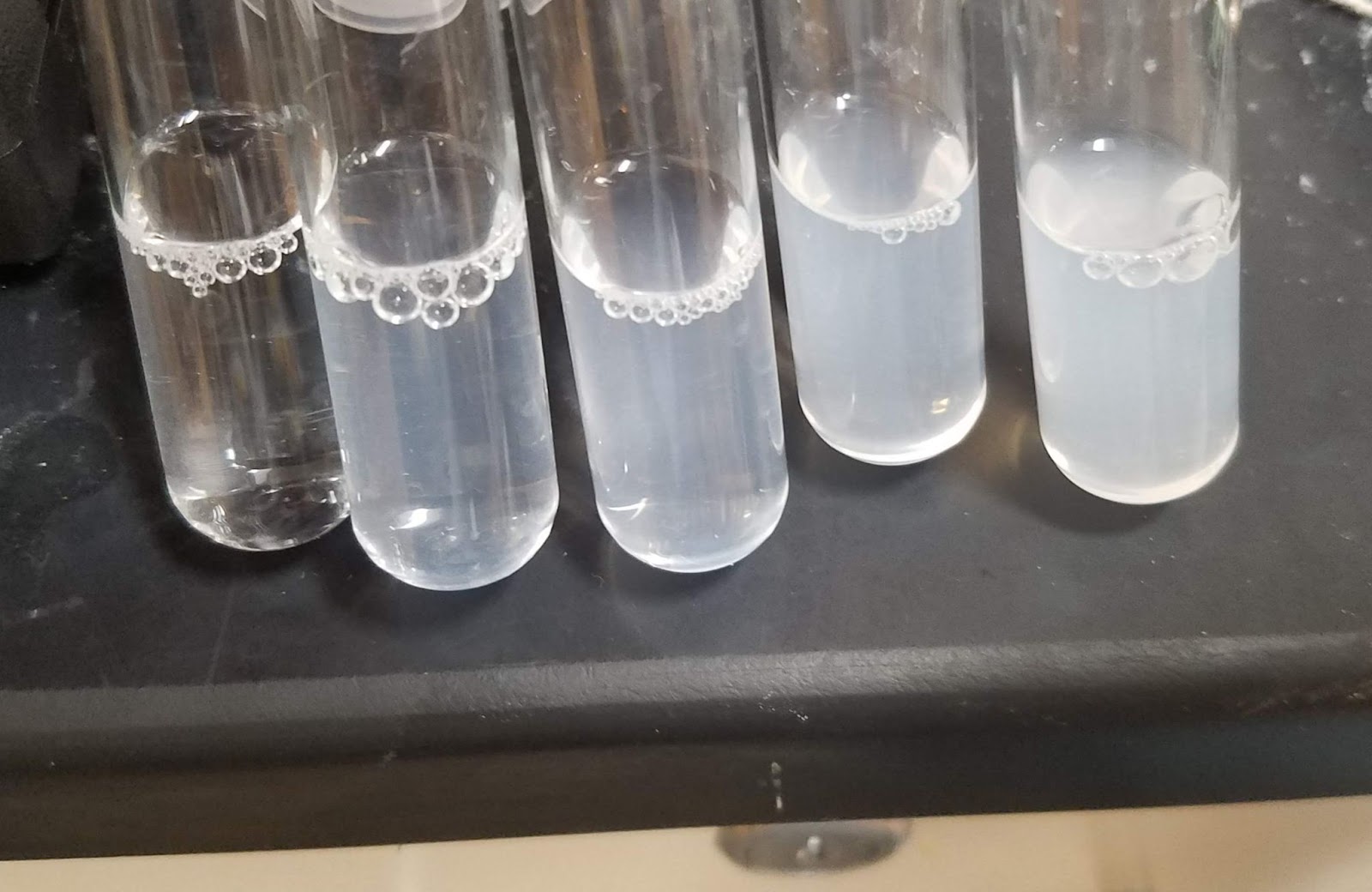
As I continue to work through the details, I would just add that this is a known effect. I've encountered it in my professional work.
What happens is the very hydrophilic ammonium cations on the polymer complex with the very hydrophilic sulfate anions on the SDS, leaving the very hydrophilic parts shielded by the hydrophobic tails of the SDS (the dodecyl part) and some of the less hydrophilic parts of the polymer. The consequence is the outer surfaces of the complex are far less hydrophilic and soluble than the individual components, and micelles and larger precipitated structures that scatter light and become visible are formed.
Here's a discussion of the process happening:
Randy Holmes-Farley
Reef Chemist
View Badges
Staff member
Super Moderator
Excellence Award
Expert Contributor
Article Contributor
R2R Research
My Tank Thread
- Joined
- Sep 5, 2014
- Messages
- 67,339
- Reaction score
- 63,686
It seems that even at 4.5% polixetonium chloride, microbial activity isn’t prevented and if organics had been added to Vibrant, then they would not be stable.
I would add that this too is expected. The ability of cationic polymers to inhibit or kill bacteria is not across the board. I have a lot of experience in this field as I led a team working on cationic polymer antimicrobials for many years. Some bacteria are easy to kill, some hard, and some nearly impossible by this means. I think a lot of it has to do with the negative charge on their membranes and what exactly is forming that charge, and the potential for cell walls in some organisms (e.g., gram-negative bacteria) or peptidoglycan .
This has more:

Cationic Antimicrobial Polymers and Their Assemblies
Cationic compounds are promising candidates for development of antimicrobial agents. Positive charges attached to surfaces, particles, polymers, peptides or bilayers have been used as antimicrobial agents by themselves or in sophisticated formulations. ...
"The cell envelopes of most bacteria fall into one of two major groups. Gram-negative bacteria are surrounded by a thin peptidoglycan cell wall, which itself is surrounded by an outer membrane containing lipopolysaccharide. Gram-positive bacteria lack an outer membrane but are surrounded by layers of peptidoglycan many times thicker than is found in the gram-negatives. Threading through these layers of peptidoglycan are long anionic polymers, called teichoic acids. The teichoic acids are responsible for the anionic properties of the bacterial cell surface [179]. In resistant strains, the teichoic acid may be replaced by alanine residues conferring reduced negative charge to the cell wall [179]. On the other hand, the lipopolyssacharides present in the complex structures of Gram-negative bacteria confer negative charges to the surface [291]. Among the polymers in Table 5, penetration in the outer membrane of the Gram-negative bacteria was optimal for PDDA due to its high hydrophobicity, whereas the other cationic polymers, more hydrophilic than PDDA, required much higher doses to exhibit activity."
@taricha amazingly presented and absolute stunning research and work! Highly appreciated. I am speechless!
thank you for your work and even more for sharing this with us.
thank you for your work and even more for sharing this with us.
Randy Holmes-Farley
Reef Chemist
View Badges
Staff member
Super Moderator
Excellence Award
Expert Contributor
Article Contributor
R2R Research
My Tank Thread
- Joined
- Sep 5, 2014
- Messages
- 67,339
- Reaction score
- 63,686
Based on what you see on the first page do you think that results show that what ever two things were tested are identical/near identical?
I think it is an excellent set of experiments that convinces me it is an algaecide containing the same chemical as other products that state their composition.
@Brian_68 I concur with this. The algeacide kills off film algae as well as GHA. Goodness knows what other surface competitors it eliminates. This creates a vacuum that dinos are well positioned to fill. Once they spool up, they chew through nutrients real quick.More likely end up with Dino’s because of lack of competing microflora. Dino’s themselfs will bottom out nutrients.
Yes, you can allow a dino event by starving out competition. But you can also do it with something like Vibrant or Chemiclean that kills surface competitors.
However vibrant does seem to kill the Dino’s as well so it appears you are safe from them as long as you keep using it.@Brian_68 I concur with this. The algeacide kills off film algae as well as GHA. Goodness knows what other surface competitors it eliminates. This creates a vacuum that dinos are well positioned to fill. Once they spool up, they chew through nutrients real quick.
Yes, you can allow a dino event by starving out competition. But you can also do it with something like Vibrant or Chemiclean that kills surface competitors.
However vibrant does seem to kill the Dino’s as well so it appears you are safe from them as long as you keep using it.
I can say for my tank, Vibrant didn't do anything but make dinos and cyano worse. It definitely did not kill the dinos in any way.
- Joined
- Dec 28, 2016
- Messages
- 22,829
- Reaction score
- 21,964
Anything used as a pesticide (even an algae pesticide) - is IMHO - after researching - required to list the ingredients. On their website - the 3.5 percent is listed as 'RODI water' - so we can get over that 'scandal'. None of this is meant to take away from @taricha s work.I would like to understand the requirements for labeling and if this is not as cut and dry. At 30% concentration OSHA does not feel there is any hazard on the MSDS, the health rating is only a 1, and this concentration in Algaefix (or perhaps Vibrant) is only 4.5%, not 30% on the MSDS.
"
OSHA Regulatory Status: This chemical is not considered hazardous by the 2012 OSHA Hazard
Communication Standard (29 CFR 1910.122). Not a dangerous substance or mixture according to the
Globally Harmonized System (GHS)."
To whoever said it - (cant remember) - not all bacteria or spores are killed by disinfectants. Pseudomonas for example can LIVE in betadine, bacteria can live in/near boiling hot springs, etc etc.
Again - the conclusion seems to be - the tests done appear to show the presence of some amount of QUAT-like compound.
Similar threads
- Replies
- 3
- Views
- 135
- Replies
- 8
- Views
- 124
- Replies
- 2
- Views
- 184
- Replies
- 21
- Views
- 368
-
- AMS: Article
- Replies
- 61
- Views
- 4,110



















